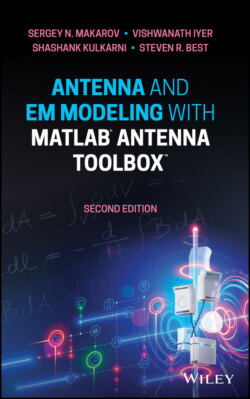Читать книгу Antenna and EM Modeling with MATLAB Antenna Toolbox - Sergey N. Makarov - Страница 34
1.9 ANTENNA REFLECTION COEFFICIENT WITH A FEEDING TRANSMISSION LINE
ОглавлениеNow, consider a generator connected to the antenna through a lossless transmission line (a coaxial cable, a printed microstrip, or a waveguide). The familiar lumped circuit in Figure 1.7a (and Figure 1.3) is transformed as shown in Figure 1.7b. In many practical situations, the transmission line is precisely matched to the generator; its characteristic impedanceZ0 is chosen to be equal to the generator resistance, that is
(1.22)
Figure 1.7 Equivalence of the TX circuits with and without the transmission line from the viewpoint of the power delivered to the antenna.
Our goal is to find the reflection coefficient of the combined system consisting of the antenna and the transmission line of length l in Figure 1.7b. The z‐axis will be directed from the source to the antenna along the transmission line. To be consistent with the lumped‐circuit approach from Example 1.7, we set the origin of the z‐axis (z = 0) in the antenna reference plane in Figure 1.7b. Then, both the incident (traveling to the right) and the reflected (traveling to the left) waves in Figure 1.7b will have the following phasor form (time dependence is exp(jωt)):
(1.23)
according to the familiar one‐dimensional plane wave theory. Here, k is the real wavenumber of the lossless transmission line. It is equal to the angular frequency divided by the phase velocity (propagation speed), c, of the line. Voltage wave V+ propagates from left to right and corresponds to cos(ωt − kz) in time domain while voltage wave V− propagates from right to left and corresponds to cos(ωt + kz). Note that k = β in Pozar's book [1].
According to Eq. (1.18) and (1.23), the reflection coefficient of the antenna with the transmission line in reference plane * in Figure 1.7b, i.e. at the generator where z = − l, has the form:
(1.24)
where Γ0 is given by Eq. (1.21) with Rg = Z0. When transmission line length tends to zero, Eq. (1.24) is indeed reduced to Eq. (1.21). Eq. (1.24) is a simple yet powerful result; it will predict the average power delivered to the antenna with a cable or another transmission line.
Example 1.8 shows that the addition of the lossless transmission line perfectly matched at the generator does that change average power delivered to the antenna, irrespective of the value of its input impedance.
